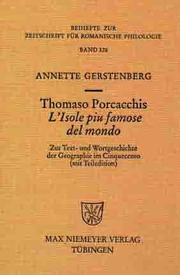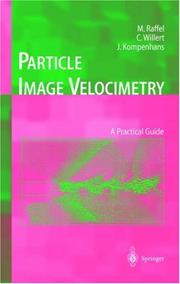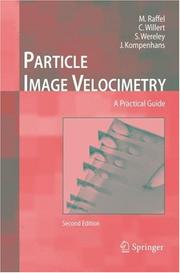| Listing 1 - 10 of 42 | << page >> |
Sort by
|
Book
ISBN: 1000008267 3866442440 Year: 2008 Publisher: KIT Scientific Publishing,
Abstract | Keywords | Export | Availability | Bookmark
 Loading...
Loading...Choose an application
- Reference Manager
- EndNote
- RefWorks (Direct export to RefWorks)
Simultaneous 2D pressure and 2D velocity information at the rough water-sediment interface of streambeds were gained by a newly developed measurement setup. In the bed the pressure fluctuations decay exponentially within the first 1-2 equivalent sand roughnesses. Structural findings concerning coherent flow structures are consistent with models originally developed for smooth walls. A significant bed destabilizing flow-pressure pattern was identified for the first time.
open channel flow --- pressure sensors --- coherent structures --- gravel bed --- PIV
Book
Year: 2005 Publisher: Gaithersburg, MD : U.S. Dept. of Commerce, Technology Administration, National Institute of Standards and Technology,
Abstract | Keywords | Export | Availability | Bookmark
 Loading...
Loading...Choose an application
- Reference Manager
- EndNote
- RefWorks (Direct export to RefWorks)
SP 800-73 specifies smart card interfaces used to retrieve and use identity credentials. These specifications reflect the design goals of interoperability and PIV Card functions. The goals are addressed by specifying PIV data model, communication interface, and application programming interface (API). Specifications include the PIV data model, API, and card interface requirements necessary to comply with the mandated use cases for interoperability across deployments or agencies. Interoperability is defined as the use of PIV identity credentials such that client APIs, compliant card applications and compliant integrated circuit cards can be used interchangeably by information processing systems across Federal agencies. SP 800-73 does not address the back-end processes that must be performed to attain full identity assertion. The document describes two realizations of the client-application programming and card command interfaces for personal identity verification: the transitional interfaces and the end-point interfaces. Transitional interfaces may be used by agencies with an existing identity card program as an optional step in evolving to the end-point interfaces. End-point interfaces are used by agencies without an existing identity card program and by agencies that elect to evolve to the end-point interface in one step rather than two. SP 800-73 is divided into three parts: Part 1 provides specifications common to both the transitional and end-point interfaces and guidance on strategies for migrating from the transitional interfaces to the end-point interfaces; Part 2 describes the subsets of GSC-ISv2.1 that comprise the transitional interfaces to the PIV data model; and Part 3 describes the PIV data model's end-point interfaces.
Biometric identification --- Identification cards --- Smart cards --- Specifications. --- FIPS 201 --- HSPD-12 --- PACS --- PIV --- PIV authentication mechanisms --- Smart Card
Dissertation

Year: 2023 Publisher: Liège Université de Liège (ULiège)
Abstract | Keywords | Export | Availability | Bookmark
 Loading...
Loading...Choose an application
- Reference Manager
- EndNote
- RefWorks (Direct export to RefWorks)
Aircraft engine intakes have presented design and propulsive challenges since modern civil and military vehicles took flight. Be it for complex upstream geometries and flow paths or for flight envelope manoeuvres during taxi, take-off climb or cruise, one of the most important remains inlet distortion, and as such, it requires accurate flow characterisation. Inlet distortion comes in the form of swirling and/or pressure patterns, thus the need of both reliable 3D time-resolved velocity and pressure information. Although with downsides, Stereoscopic Particle Image Velocimetry has proven reliable in providing time-resolved velocity datasets of high spatial resolution. Pressure from PIV presents an alternative to intrusive rake probes for such data acquisitions in spite of its complexity, cost, an uncertainty quantification. In this context, the current project aims to design a low speed wind tunnel experiment for inlet distortion SPIV and the development of a post-processing tool to retrieve pressure from PIV. The distortion is achieved by means of pressure and swirl devices that create different flow patterns to be temporally investigated. Laser sheet optics were tested, proper focus on the desired field of view was demonstrated with Scheimpflug adaptors, and a 3D calibration plate was devised. Steady space marching integration and poisson methods were developed and compared to retrieve the pressure field from three interpolated 'synthetic' CFD case studies. In light of the apparent flow characteristics disparity between the three case studies, the incompressibility assumption was evaluated just as the computation of axial gradients. Space marching performed below poisson for most cases and assumptions. Incompressible assumption captured surprisingly accurately pressure gradients and distortion under Mach number conditions that would not be considered incompressible. Axial gradients had a mostly non-positive effect: computing them saw irrelevant positive effect on accuracy or significantly added up to computation error.
Book
Year: 2005 Publisher: KIT Scientific Publishing
Abstract | Keywords | Export | Availability | Bookmark
 Loading...
Loading...Choose an application
- Reference Manager
- EndNote
- RefWorks (Direct export to RefWorks)
Shallow turbulent wake flows are generated by large obstacles - like islands or headlands - introduced to shallow turbulent open-channel flows. Large-scale quasi two-dimensional vortices may shed off from an obstacle, and advect downstream in a vertical shear flow with predominantly small-scale turbulence induced by bottom friction. Experimental, analytical, and numerical techniques are employed in the present study to characterize the mean flow and turbulence properties of shallow wakes; mechanisms of generation and decay of large-scale vortical structures are clarified, as is their influence on momentum and mass transport in shallow wakes; the global and local stability of shallow wakes is analyzed and evidenced from experimental data. Part I of this work covers non-intrusive optical measurement techniques especially adapted to investigate shallow shear flows. Flow velocities and mass concentrations are obtained (i) point-wise with high spatiotemporal resolution using a combinded LDV-LIF system, and (ii) field-wise using near-surface PIV and depth-averaged PCA systems with a coupling by phase-resolved averaging. Improved algorithms for the evaluation of mass concentrations are based on hydro-optical models of the underlying fluorescence and light attenuation processes. Part II addresses the time-mean description of shallow wake flows. The stochastic description of the turbulence fields displays a characteristic spectral distribution both of kinetic energy and of mass variance, which is partially consistent with the theory of unbounded 2D turbulence at large scales, and with the theory of homogeneous 3D turbulence at small scales. An integral wake model including the effect of bottom friction is derived analytically, and is validated by experimental data. The time-mean distributions of flow velocities and of mass concentration allow to identify wake near fields and far fields with specific asymptotic wake developments. Wake stability classes are associated with local stability regions suggested by linear stability analyses. Part III elaborates the structure and dynamics of quasi-periodic wake flows and the significance of large-scale eddies. This involves a structure identification scheme to educe individual vortices, and a phase-resolved averaging procedure to decompose the flow fields into large-scale coherent and small-scale turbulent parts. A Numerical Particle Tracking technique is employed to model the mass transport and to elucidate different diffusion and dispersion effects.
vortex street --- wake flow --- flow measurement --- LIF --- shallow water --- turbulence --- coherent structure --- PCA --- mass transport --- light absorbtion --- PIV --- LDV --- light absorption

ISBN: 1281956007 9786611956004 9812796614 9789812796615 9789812389497 9812389490 9789812389145 9812389148 9812389490 9781281956002 661195600X Year: 2004 Publisher: Hackensack, NJ London
Abstract | Keywords | Export | Availability | Bookmark
 Loading...
Loading...Choose an application
- Reference Manager
- EndNote
- RefWorks (Direct export to RefWorks)
This volume introduces particle image velocimetry (PIV), a technique for water wave measurement in the laboratory and in the open ocean. It discusses the turbulent dissipation, Reynolds stresses and vortical structures in boundary layers of the sea bed, as well as ships, ship wakes, propulsion hydrodynamics, cavitation and free surface waves. Upwelling behind crests of micro-breaking ocean surface waves (important for the exchange of greenhouse gases between air and water) and large amplitude internal solitons in the ocean are measured. The book includes velocities and accelerations in breaki
Particle image velocimetry. --- Water waves. --- Breakers --- Surface waves (Water) --- Hydrodynamics --- Waves --- Wind waves --- Particle image displacement velocimetry --- Particle imaging velocimetry --- PIV (Particle image velocimetry) --- Speckle velocimetry --- Flow visualization --- Velocimetry

ISBN: 3484523263 3110944367 9783484523265 Year: 2004 Volume: 326 Publisher: Tübingen: Niemeyer,
Abstract | Keywords | Export | Availability | Bookmark
 Loading...
Loading...Choose an application
- Reference Manager
- EndNote
- RefWorks (Direct export to RefWorks)
Die Studie bahnt als Beitrag zur italienischen Sprachgeschichtsschreibung nichtliterarischer Texte einen Zugang zum kaum bekannten Bereich der frühneuzeitlichen Geographie. Als Kompilation der wichtigsten geographischen Texte seiner Zeit ist Porcacchis »L'Isole piu famose del mondo« (Venedig, 1. Auflage 1572) repräsentativ für die geographische Textgeschichte des Cinquecento. Sie wird in der systematisierenden Erfassung von Porcacchis Quellen nachgezeichnet, Interessensschwerpunkte bilden Übersetzungen, ihr Adressatenkreis und zeitgenössische auch mündliche Diskurstraditionen. Ergänzend wird die Begriffsgeschichte von it. geografia an Hand von Quellenbelegen nachvollzogen. Porcacchis Text wird als Zeugnis eines mittleren Sprachgebrauchs, der lingua corrente, analysiert und als typische Arbeit eines Verlagsmitarbeiters und poligrafo im Umfeld der venezianischen Buchproduktion kontextualisiert. »L'Isole piu famose del mondo« stellt eine eher redaktionelle als originelle Leistung dar. Die spezifische Schreibttechnik, die Überformung von Vorlagentexten (riscrittura), wird erläutert und in Synopsen verdeutlicht. In textlinguistischer Hinsicht wird die Kompilation als ›Kompilation von Textsorten‹ interpretiert. Der Quellenwert geographischer Texte wird in Belegdokumentationen zu geographischen Termini und den Inselnamen des von Porcacchi als Arcipelago beschriebenen Raumes diskutiert. Die Untersuchung basiert auf einer integralen Edition, deren zentrale Kapitel im Band enthalten sind.
Italian philology. --- Raeto-Romance philology. --- Philologie italienne --- Porcacchi, Thomaso, --- Italian philology --- Raeto-Romance philology --- Geography --- Names, Geographical --- Terminology --- History --- Terminology. --- History. --- Géographie --- Terminologie --- Geographic names --- Geographical names --- Place names --- Placenames --- Toponyms --- Names --- Toponymy --- Topographical terms --- Geography - Terminology --- Names, Geographical - History --- Porcacchi, Thomaso, - approximately 1530-1585? - Isole piv famos del mondo

ISBN: 3540636838 3662036398 3662036371 Year: 1998 Publisher: Berlin : Springer,
Abstract | Keywords | Export | Availability | Bookmark
 Loading...
Loading...Choose an application
- Reference Manager
- EndNote
- RefWorks (Direct export to RefWorks)
Results from several applications of particle image velocimetry (PIV) to unsteady flows at a laboratory scale have been published, and commercial products are now available for more general laboratory use, but for certain industrially important applications, reliable equip-ment is often available only from in-house research and development teams. This PIV handbook is intended to transfer know-how from PIV development laboratories to end-users in industry and universities. The book discusses the scientific and technical aspects required to set up a PIV system, allows users to assess the problems involved in the application of PIV, and enables them to design, optimize, and use PIV systems to meet their special needs.
Hydrodynamique --- Hydrodynamics --- Mesure --- Measurement --- Holographic interferometry. --- Particle image velocimetry. --- Monograph --- Thermodynamics. --- Physical measurements. --- Measurement . --- Engineering. --- Measurement Science and Instrumentation. --- Engineering, general. --- Construction --- Industrial arts --- Technology --- Measuring --- Mensuration --- Mathematics --- Metrology --- Physical measurements --- Measurements, Physical --- Mathematical physics --- Chemistry, Physical and theoretical --- Dynamics --- Mechanics --- Physics --- Heat --- Heat-engines --- Quantum theory --- Diffraction patterns --- Holography --- Interferometry --- Particle image displacement velocimetry --- Particle imaging velocimetry --- PIV (Particle image velocimetry) --- Speckle velocimetry --- Flow visualization --- Velocimetry

ISBN: 1281070300 9786611070304 3540723080 3540723072 3642431666 Year: 2007 Publisher: Heidelberg ; New York : Springer,
Abstract | Keywords | Export | Availability | Bookmark
 Loading...
Loading...Choose an application
- Reference Manager
- EndNote
- RefWorks (Direct export to RefWorks)
This practical guide intends to provide comprehensive information on the PIV technique that in the past decade has gained significant popularity throughout engineering and scientific fields involving fluid mechanics. Relevant theoretical background information directly support the practical aspects associated with the planning, performance and understanding of experiments employing the PIV technique. The second edition includes extensive revisions taking into account significant progress on the technique as well as the continuously broadening range of possible applications which are illustrated by a multitude of examples. Among the new topics covered are high-speed imaging, three-component methods, advanced evaluation and post-processing techniques as well as microscopic PIV, the latter made possible by extending the group of authors by an internationally recognized expert. This book is primarily intended for engineers, scientists and students, who already have some basic knowledge of fluid mechanics and non-intrusive optical measurement techniques. It shall guide researchers and engineers to design and perform their experiment successfully without requiring them to first become specialists in the field. Nonetheless many of the basic properties of PIV are provided as they must be well understood before a correct interpretation of the results is possible.
Particle image velocimetry. --- Holographic interferometry. --- Diffraction patterns --- Holography --- Interferometry --- Particle image displacement velocimetry --- Particle imaging velocimetry --- PIV (Particle image velocimetry) --- Speckle velocimetry --- Flow visualization --- Fluid dynamic measurements --- Hydraulic engineering. --- Chemical engineering. --- Thermodynamics. --- Engineering Fluid Dynamics. --- Classical and Continuum Physics. --- Fluid- and Aerodynamics. --- Industrial Chemistry/Chemical Engineering. --- Measurement Science and Instrumentation. --- Chemistry, Physical and theoretical --- Dynamics --- Mechanics --- Physics --- Heat --- Heat-engines --- Quantum theory --- Chemistry, Industrial --- Engineering, Chemical --- Industrial chemistry --- Engineering --- Chemistry, Technical --- Metallurgy --- Engineering, Hydraulic --- Fluid mechanics --- Hydraulics --- Shore protection --- Velocimetry --- Fluid mechanics. --- Continuum physics. --- Fluids. --- Physical measurements. --- Measurement . --- Measuring --- Mensuration --- Mathematics --- Technology --- Metrology --- Physical measurements --- Measurements, Physical --- Mathematical physics --- Measurement --- Hydrostatics --- Permeability --- Classical field theory --- Continuum physics --- Continuum mechanics --- Hydromechanics
Book
ISBN: 3039287435 3039287427 Year: 2020 Publisher: MDPI - Multidisciplinary Digital Publishing Institute
Abstract | Keywords | Export | Availability | Bookmark
 Loading...
Loading...Choose an application
- Reference Manager
- EndNote
- RefWorks (Direct export to RefWorks)
This Special Issue of Processes operates on the basis of a rigorous peer-review with a single-blind assessment and at least two independent reviewers, thereby ensuring a high quality final product. I would like to thank our reviewers, for providing the authors with constructive comments, and Editorial Board, for their professional advice that led to the final decision. I am sure that, in coming years, readers of this Special Issue will find the scientific manuscripts interesting and beneficial to their research.
three-dimensional temperature field --- n/a --- forced convection --- RNG k-? model --- PIV measurements --- water friction loss --- flat plate --- horizontal --- optimization --- casson fluid --- finned tube --- plate-fin heat sink --- computational fluid dynamics (CFD) --- plate heat exchanger --- partial heating --- thermo-diffusion --- HEN synthesis --- Keller-Box technique --- visualization experiment --- ice-cream --- modelling --- computational intelligence techniques --- canned motor --- boiling --- heat transfer --- operating condition --- vertical --- phase change --- flow distribution characteristics --- scraped surface heat exchanger --- heat flux --- numerical simulation --- aspect ratio --- orientation --- axisymmetric flow --- CACRS --- natural convection --- MINLP --- multi-slip --- ice storage --- viscosity --- axial piston pump --- crystallization --- multiphase flow
Book
Year: 2021 Publisher: Basel, Switzerland MDPI - Multidisciplinary Digital Publishing Institute
Abstract | Keywords | Export | Availability | Bookmark
 Loading...
Loading...Choose an application
- Reference Manager
- EndNote
- RefWorks (Direct export to RefWorks)
Life below water is the 14th Sustainable Development Goal (SDG) envisaged by the United Nations and is aimed at conserving and sustainably using the oceans, seas, and marine resources for sustainable development. It is not difficult to argue that signals and image technologies may play an essential role in achieving the foreseen targets linked to SDG 14. Besides increasing the general knowledge of ocean health by means of data analysis, methodologies based on signal and image processing can be helpful in environmental monitoring, in protecting and restoring ecosystems, in finding new sensor technologies for green routing and eco-friendly ships, in providing tools for implementing best practices for sustainable fishing, as well as in defining frameworks and intelligent systems for enforcing sea law and making the sea a safer and more secure place. Imaging is also a key element for the exploration of the underwater world for various scopes, ranging from the predictive maintenance of sub-sea pipelines and other infrastructure projects, to the discovery, documentation, and protection of sunken cultural heritage. The scope of this Special Issue encompasses investigations into techniques and ICT approaches and, in particular, the study and application of signal- and image-based methods and, in turn, exploration of the advantages of their application in the previously mentioned areas.
Technology: general issues --- passive sonar --- weak target detection --- robust Capon beamforming --- large DOA mismatch --- two-step steering vector estimation --- free surface recording --- waves --- bubbles --- PIV --- wave flume experiments --- Voronoi partition --- mobile sensor networks --- wireless sensor networks --- environmental monitoring --- marine environment --- oil spills --- ship --- navigation systems --- dynamic positioning --- signal filtering --- signal processing --- time-frequency representation --- Kalman filter --- estimation --- directional wave spectra --- distributed jamming technology --- layout strategy --- underwater acoustic sensor networks --- Cramér–Rao bound --- underwater image enhancement --- Multi-Scale Retinex --- parameter optimization --- no reference image quality assessment --- n/a --- Cramér-Rao bound
| Listing 1 - 10 of 42 | << page >> |
Sort by
|

 Search
Search Feedback
Feedback About UniCat
About UniCat  Help
Help News
News